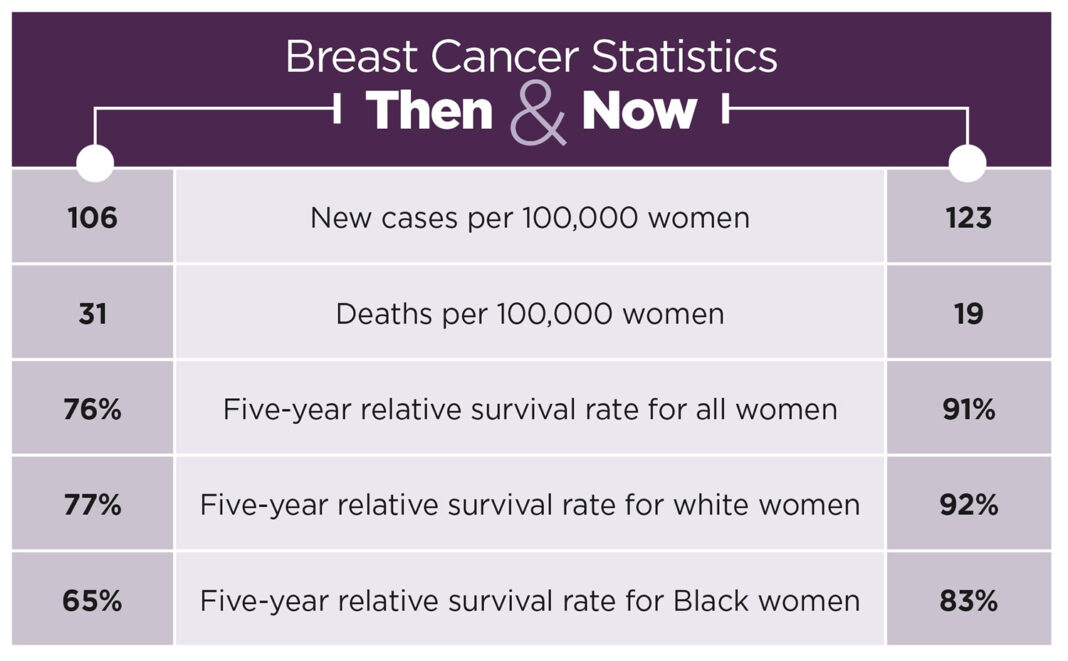One of the best things that can happen to a patient throughout therapy is breast cancer remission. Remission, as used in medicine, is when imaging tests show no evidence of breast cancer. Remission, however, signifies much more to patients and their families—it’s a time of relief, hope, and the potential to resume life after a challenging journey.
However, remission isn’t always permanent, and patients and caregivers can better prepare for the future by knowing what factors affect remission rates.
What Does Breast Cancer Remission Mean?
When tests and scans reveal no detectable evidence of breast cancer, a patient is said to be in remission. At this stage, crucial information on the treatment’s efficacy and the optimal course of action is given. Some may need to continue routine checkups to reduce the risk of recurrence, while others may need to consider additional therapies.
Key Factors That Influence Remission
Not every remission journey is the same. Several factors affect both the chances of remission and how long it may last:
- Stage of cancer: Early detection is strongly linked to higher remission and survival rates.
- Tumor characteristics: Size, grade, and hormone receptor status matter. For example, hormone receptor-positive cancers tend to respond better to hormone therapies.
- Cancer subtype: Different types respond differently to treatments. Triple-negative breast cancer (TNBC), for instance, has higher recurrence risks than hormone receptor-positive cancers. Learn more about breast cancer subtypes.
- Treatment plan: Surgery, chemotherapy, radiation, and targeted therapies all influence outcomes.
- Overall health: Lifestyle factors such as weight, smoking, and underlying health conditions can affect how the body responds to treatment.
- Adherence to treatment: Following the treatment plan as recommended by doctors significantly boosts remission chances.
Remission Rates by Breast Cancer Subtype
While exact remission statistics are hard to pin down, recurrence rates offer some perspective. Studies suggest that 25%–30% of breast cancer patients may experience recurrence at some point.
Here’s a breakdown by subtype:
- Luminal A (HR-positive, HER2-negative): Most favorable outcomes, with longer disease-free survival averaging about 56 months.
- Luminal B (HR-positive, HER2-positive or negative): Moderate outlook, with recurrence around 48 months.
- Triple-Negative Breast Cancer (TNBC): More aggressive and harder to treat, with recurrence averaging 27 months.
- HER2-positive: Often aggressive but responsive to targeted therapies, with recurrence around 34 months.
For a deeper dive into recurrence data, check out this National Cancer Institute resource.
Life After Treatment: Long-Term Outcomes
Remission is just one part of survivorship. Long-term care plans are essential to help survivors manage both physical and emotional challenges:
- Regular follow-ups: Ongoing scans and checkups are critical for spotting recurrence early.
- Managing side effects: Some survivors face fatigue, lymphedema, or chronic pain long after treatment.
- Mental health support: Feelings of anxiety or depression are common. Support groups, therapy, and counseling play a key role in recovery.
Coping with the Fear of Recurrence
It’s natural to worry about cancer returning. Many survivors describe this fear as one of the hardest parts of remission. Here are strategies that can help:
- Talk to a professional: Counselors and therapists specializing in cancer survivorship can provide tools for managing anxiety.
- Stay connected: Support groups—both in person and online—help survivors share their fears and find encouragement.
- Mind-body practices: Yoga, meditation, and breathing exercises can improve emotional resilience.
- Stick with follow-ups: Routine medical visits can bring peace of mind and catch any changes early.
You can explore survivor-led support networks through Cancer Support Community.
The Role of Lifestyle in Supporting Remission
Living a healthy lifestyle after remission may not guarantee cancer won’t return, but it can lower risks and improve overall well-being. Research shows lifestyle factors significantly affect survivorship:
- Nutrition: Diets rich in vegetables, whole grains, lean proteins, and healthy fats may reduce recurrence risk. Anti-inflammatory diets, in particular, are linked to improved outcomes.
- Exercise: Regular physical activity before and after diagnosis is associated with better survival rates.
- Avoiding smoking: Non-smokers have substantially higher survival rates compared to those who smoke.
- Stress management: Mindfulness, relaxation techniques, and adequate sleep support both emotional and physical health.
For nutrition guidance, the American Institute for Cancer Research offers evidence-based recommendations.
Bottom Line
A remarkable accomplishment, achieving remission from breast cancer is evidence of fortitude, successful therapy, and resiliency. However, being a survivor is a process rather than a destination. Survivors can enhance their quality of life and long-term results by maintaining a healthy lifestyle, receiving both medical and emotional support, and being proactive with checkups.
Remember that you are not alone if you or a loved one is going through remission. Remission can serve as the cornerstone for a healthier, more independent future with the correct assistance and care.
